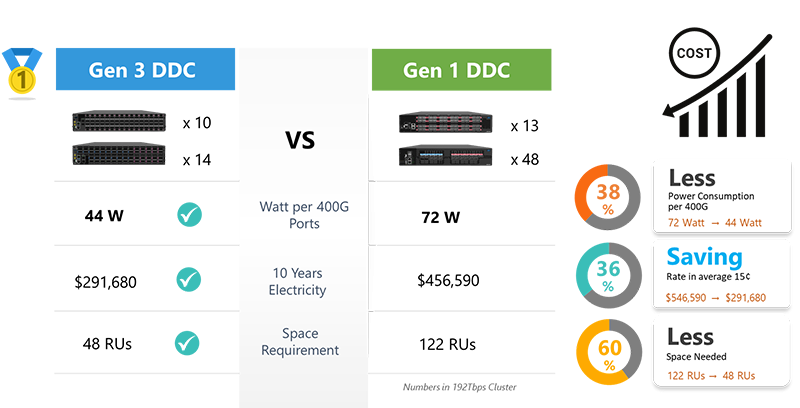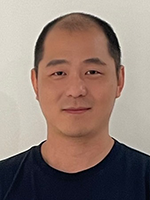The Rise of Artificial Intelligence Skyrockets 800G Adoption
This year, 2025, marks the 52nd anniversary of Ethernet's invention in 1973. Looking back, it took nearly 37 years from Ethernet's inception for 100Gbps to become a standard in 2010. In the decade that followed, we've witnessed the introduction of multiple speed standards that precisely reflect the diverse demands of the market across various scenarios, continuously driving the evolution of high-end telecommunications and data center networks.
Cloud service providers are industry leaders who explore innovative ways to adopt new speeds, and the telecom transport network will follow. In the past few years, the AI boom is a catalyst for migration to a higher-speed network. A new era for 800G is about to reducing power consumptiontake off and pave the way to 1.6T.
This blog examines the advantages of upgrading to faster speeds, addresses service providers' reservations, and explores market solutions to these uncertainties.

Figure 1. Ethernet roadmap (Source: Ethernet Alliance)
▪ Cost implications of 800G
The benefits of upgrading networks to a higher speed are plentiful. Alongside offering a higher service capacity, cost is one of the main reasons for the move.
Generally speaking, the OPEX of a data center is much higher than the CAPEX. Electricity and the cost of space are major contributors to the OPEX.
Reducing power consumption
According to a report from Equinix, electricity represents 23% of operational spending . With inflation and climate change, power costs are anticipated to increase steadily over the coming years. Many new technologies are addressing this issue by lowering system power consumption and optimizing heat dissipation.
The new semiconductor process can increase transistor density while decreasing power consumption. For example, TSMC claimed its 5nm chips can reduce power consumption by 25% - 30% with the same performance as 7nm chips .
Another factor is heat management. Good thermal design can increase the efficiency of heat dissipation and prevent fans from operating at full speed, reducing power consumption. Maximizing the venting hole area to increase airflow, leveraging the air baffle to maintain the airflow integrity, and using a heat sink to conduct heat to the chassis are all common approaches to optimize thermal performance.
Optimizing space utilization
Finding suitable areas to rent is also challenging. In brownfields, where space is fixed, service providers must optimize space utilization while accommodating the growing traffic demand.
The new generation ASIC brings higher density and consumes less space. Broadcom Tomahawk 5 with 51.2 Tbps switching capacity delivers a more efficient service compared to the 6 of 25.6 Tbps ASIC machines required previously.
Take the Distributed Disaggregated Chassis (DDC) platform that leverages CLOS topology to build a virtual chassis as an example. Comparing the 1st and 3rd generation DDCs, the 3rd generation 800G platform requires 60% less space and consumes 38% less power when providing the same service capacity.

Figure 2. New generation platform brings higher efficiency
▪ Considerations when adopting new technologies
Migrating infrastructure is a huge task. Here are a few things for service providers to keep in mind before adopting a new technolog.
Signal degradation and reliability
Higher data transmission rates can make the signal more susceptible to degradation. Service providers are concerned about maintaining signal integrity over long distances and across various network elements.
Traditional circuit designs with copper traces can no longer carry higher speed signals. Using an external cable to replace the PCB routing can minimize signal loss and enable higher-speed signal transmission. A further step is Co-Packaged Optics (CPO), which integrates optics components into ASIC packages, minimizes the electrical link length, and delivers the signal in the optical domain.

Figure 3. Solution for high speed signal transmission
Interoperability
From software to routers, all components involve transmission, and parties must be on board to successfully enable the new infrastructure. They must also consider compatibility with existing infrastructure.
Although implementation largely follows industrial standards, the devil is in the details. Any minor difference in the implementation stage might cause interoperability issues.
Interoperability involves two areas: software and hardware. Software interoperability mainly refers to the functional testing between routers that ensures communication is going well. Many Plugfest events focus on software interoperability, and service providers always request a lab test to ensure new devices can fit into the network alongside existing equipment.
Hardware generally focuses on the components level, especially the transceivers. A router must prove itself as fit to work with existing transceivers that are used by the service providers, as well as new generation technology such as the latest speed or standards. A close collaboration between network equipment vendors and transceiver vendors will be very important to ensure seamless integration.
UfiSpace is 800G-ready
The insatiable demand for Artificial Intelligence (AI) continues to drive an unprecedented boom in 800G network adoption. This surge isn't confined to the AI data center; it's rapidly extending its reach into the wider transport network infrastructure. As AI workloads scale and data movement intensifies, high-capacity, efficient networking becomes paramount.
UfiSpace is at the forefront of this evolution, leading the market with a comprehensive suite of 800G solutions for both transport networks and data centers. Our cutting-edge portfolio includes:
▪ TH5-based S9321-64E & S9321-64EO data center switches: Engineered for high-density, high-throughput data center environments.
▪ Jericho3-based S9720-56ED & Ramon3-based S9725-64E DDC open core routers: Providing robust, high-performance routing for core network deployments.
▪ Qumran3D-based S9620-32E open aggregation router: Designed for efficient aggregation in diverse network topologies.
Using the most advanced design, we deliver high-performance network equipment with low power consumption and unbeatable reliability. Comprehensive validation with software and hardware partners eliminates interoperability concerns. Be sure to check out our offerings or contact us for more details.
For more information, please contact our sales team.
About the Author
 |
Will Chang Will Chang, Technical Marketing Manager at UfiSpace, provides technical expertise and executes marketing campaigns on technical topics. |
